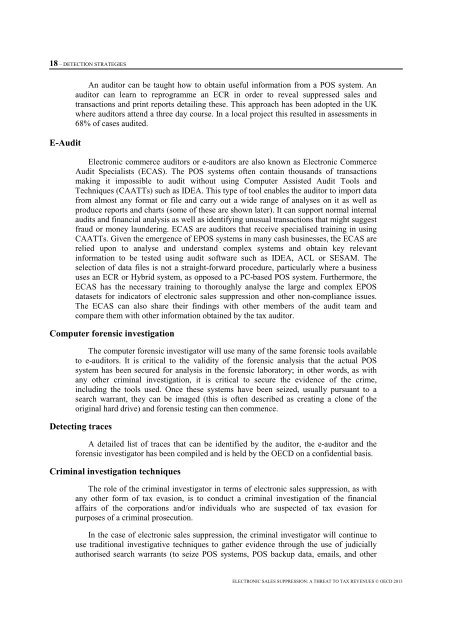ELECTRONIC SALES SUPPRESSION: A THREAT TO TAX REVENUES
ELECTRONIC SALES SUPPRESSION: A THREAT TO TAX REVENUES
ELECTRONIC SALES SUPPRESSION: A THREAT TO TAX REVENUES
Create successful ePaper yourself
Turn your PDF publications into a flip-book with our unique Google optimized e-Paper software.
18 – DETECTION STRATEGIES<br />
E-Audit<br />
An auditor can be taught how to obtain useful information from a POS system. An<br />
auditor can learn to reprogramme an ECR in order to reveal suppressed sales and<br />
transactions and print reports detailing these. This approach has been adopted in the UK<br />
where auditors attend a three day course. In a local project this resulted in assessments in<br />
68% of cases audited.<br />
Electronic commerce auditors or e-auditors are also known as Electronic Commerce<br />
Audit Specialists (ECAS). The POS systems often contain thousands of transactions<br />
making it impossible to audit without using Computer Assisted Audit Tools and<br />
Techniques (CAATTs) such as IDEA. This type of tool enables the auditor to import data<br />
from almost any format or file and carry out a wide range of analyses on it as well as<br />
produce reports and charts (some of these are shown later). It can support normal internal<br />
audits and financial analysis as well as identifying unusual transactions that might suggest<br />
fraud or money laundering. ECAS are auditors that receive specialised training in using<br />
CAATTs. Given the emergence of EPOS systems in many cash businesses, the ECAS are<br />
relied upon to analyse and understand complex systems and obtain key relevant<br />
information to be tested using audit software such as IDEA, ACL or SESAM. The<br />
selection of data files is not a straight-forward procedure, particularly where a business<br />
uses an ECR or Hybrid system, as opposed to a PC-based POS system. Furthermore, the<br />
ECAS has the necessary training to thoroughly analyse the large and complex EPOS<br />
datasets for indicators of electronic sales suppression and other non-compliance issues.<br />
The ECAS can also share their findings with other members of the audit team and<br />
compare them with other information obtained by the tax auditor.<br />
Computer forensic investigation<br />
The computer forensic investigator will use many of the same forensic tools available<br />
to e-auditors. It is critical to the validity of the forensic analysis that the actual POS<br />
system has been secured for analysis in the forensic laboratory; in other words, as with<br />
any other criminal investigation, it is critical to secure the evidence of the crime,<br />
including the tools used. Once these systems have been seized, usually pursuant to a<br />
search warrant, they can be imaged (this is often described as creating a clone of the<br />
original hard drive) and forensic testing can then commence.<br />
Detecting traces<br />
A detailed list of traces that can be identified by the auditor, the e-auditor and the<br />
forensic investigator has been compiled and is held by the OECD on a confidential basis.<br />
Criminal investigation techniques<br />
The role of the criminal investigator in terms of electronic sales suppression, as with<br />
any other form of tax evasion, is to conduct a criminal investigation of the financial<br />
affairs of the corporations and/or individuals who are suspected of tax evasion for<br />
purposes of a criminal prosecution.<br />
In the case of electronic sales suppression, the criminal investigator will continue to<br />
use traditional investigative techniques to gather evidence through the use of judicially<br />
authorised search warrants (to seize POS systems, POS backup data, emails, and other<br />
<strong>ELECTRONIC</strong> <strong>SALES</strong> <strong>SUPPRESSION</strong>: A <strong>THREAT</strong> <strong>TO</strong> <strong>TAX</strong> <strong>REVENUES</strong> © OECD 2013


